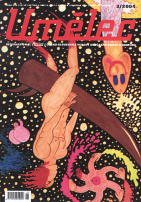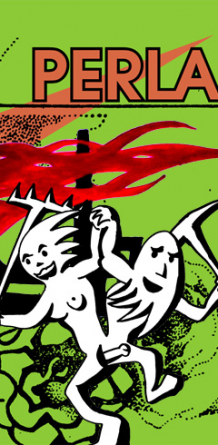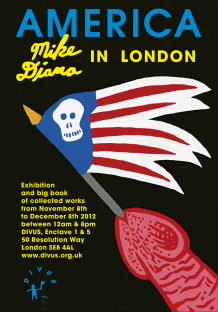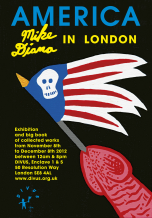The only pleasant thing left over from Christianity is the reservation of luxury and democracy. Outside this reservation, there is an exotic world of chaos inhabited by enemies. Probably the best, albeit unintentional caricature of this world concept, is the current film industry. The soiled protagonist, ragged and rain-drenched, is being beaten up by humanoid monsters gone berserk. After he disposes of them thanks to his agility—he usually manages to get out of the way of some dashing furious brute, who kills himself on the next bridge pillar—and beats to death their cynical leader with a statuette of a cruel local god. The hero returns home. As he is getting off the plane in New York, London or Frankfurt, the illuminators let us properly see his Western aristocratic features. Then we are shown pictures of progress, wealth and peace. A city from a bird’s eye view, flying over some nice central cluster-of-skyscrapers, a yacht there, the streets are full of colorful cars, mothers with prams, and grinning candy sellers. In the evening, having had a good diner the hero settles by the fireside with his wife and no more than two children, and narrates how glad he is to be back home. That is about how the agitprop programs for the life in socialist countries used to look like. As no one would watch similar odes to capitalism, we can see them at the beginning of every expensive movie, which we gladly pay for.
Principles of Contemporary Blasphemy
The story of the main hero doesn’t end with this propaganda. Although he is glad to be at home, he will still return to hell to establish democracy. We could call this Christian romanticism.
Christian romanticism is based on a few historic mistakes.
The first mistake is equality. According to western morality, all people are equal. But this first assumption doesn’t take groups into account that don’t consider it an advantage to be equal to western man. He is not, from the point of thinking and doing, considered an ideal.
Another mistake is Man’s requirement of animals—he wants them to obey his laws, to do no harm, and to be ready to be properly eaten. Animals haven’t managed to notice these laws yet, as they remain on a significantly higher level of organization (than people).
Yet another mistake is the faith in the ability of determining the degree of responsibility and the boundaries of morals. The result of this is torturing of children by forcing them into principles of self-reflection that in fact represent the frustrations and prejudices of the adult Western man applied on an innocent being. He usually prays moral to those who don’t care for it at all. Children’s inattentiveness to this teaching is regarded as a sin, a crime. It follows that the adult western individual is not able to deal with himself and therefore cannot stand being himself. And when he can’t bear himself, someone will get the worst of it.
The biggest mistake is the understanding of time in relation to reality. Every non-Christian child knows that what used to be is no longer, and what will be doesn’t exist yet. The desire to capture time and to draw all the past junk into the presence makes our world slowly uninhabitable and the result of this is the book culture—therefore a significant sin. By foretelling and depicting the future the western man brings about all possible disasters - because nothing will happen that wasn’t first invented. The western man cannot live in the present. He lives in memories and expectations.
And that is not all that he managed to spoil his and other’s life with.
We can’t wonder much about the amount of these mistakes. Western Christian civilization is founded on an application of sometimes intentional misinterpretation of the teachings of Jesus Christ, which itself is not clear enough. Not everyone loves him for that, although the world loves the adorably clumsy. If only he had not claimed that God was his father.
All these mistakes then define the modern way of blasphemy. Some unbelievers will learn about their wrongdoing only after they are revealed. Blasphemy today is not in derogation of the Commandments and other holy texts, but in refuting these modern Christian mistakes. The blaspheming people usually don’t mean to do any harm. But they are thought of badly, even if they are artists or creators. Their position has become particularly complicated in the last few years.
The evolution of society’s free judgment is gradually sterilized by censorship and higher political interests. The extent of freedom and democracy is being measured distortedly by the ability to absorb the vulgar pop and not by the thoughtfulness towards radical and substantial ideas. It is with both fear and joy that I present some of them to you here.
Satan’s Children
This is nothing new. In some cases, this is more-or-less a conscious revival of the movement of radical dirty art activists around the group NO!Art. These artists, led by Boris Lurie, and exhibiting in the gallery March, employed an armory of the cruelest and most perverted images. Their activities were too much even in the relaxed sixties in America. But Boris Lurie, as a concentration camp survivor, could hardly be blamed for being a naive, pampered intellectual. These artists didn’t like the world is governed by political cynicism and built on the principles of Christian hypocrisy, and they let it know loudly.
Of course we could find comparison much deeper in the history. The first activists and unscrupulous critics of society include Francisco de Goya, Alfred Kubin and Josef Váchal. That is why the outrage about their followers is so surprising. An important role in their acceptance plays the elevating into the sphere of art. Moralists don’t care about the radical artists exhibited in luxury institutions, elite shows and expensive biennials. The moment the artist appears in such places, his work is under the protective wing of investment. And culture backed by a lot of money is never morally criticized or even questioned.
Not so fortunate are artists from the so-called dirty level, who were never able to get into the sphere of art because of formal imperfections or social non-conformity. Their fate is usually in the hands of police, psychiatrists or oblivion.
From the point of conservative conception of personality development, some of them insist on holding to a childish style of depicting, not unlike art brut. The children’s principles they have in the understanding of justice, functioning of the society and experimenting with the endurance of the human being. Some of these artists have already been criminalized for their expressions. While looking at their work, one must keep wondering whether the lowering of the age of criminal liability wouldn’t cause arrests among most children for their cruel scrawls.
The Great Catholic Performance
Imagine a huge public appearance of the Pope Jan Pavel II. The Holy Father is sitting comfortably in his chair and the audience, consisting mostly of young believers, is crazy with expectation. One of the officials announces that the Holy Father will speak. But the Holy Father is silent. He sits, smiling, and he hoots every now and then. Quite cheerfully, in different keys like a lover summoning his girl behind a bush or like an inquisitive owl. He keeps doing this for a long time. The audience is frantic. The officials are nervous. And the Pope is howling away. Hoo hoo hoooo... Some half an hour later someone in the TV crew gathers the courage to break off the broadcast. Unbelievable! This maybe wasn’t true. But you can see it in Performance, a documentary of a German video artist Oliver Pietsch.
If you watch the shot of the last moments of Jesus Christ in all the existing movies, you will be disturbed and touched at first. But then you begin to wonder whether the crucifixion is not just kitsch. Opposites are poetically and scientifically very close. Suffering and satisfaction. A corpse on a crucifix and a smiling dwarf that almost speaks. Both are often made of plaster.
The magic of the work of Oliver Pietsch lies in piling up of tense moments. It usually starts quietly, but step-by-step he thrills you to suffocation. First he makes you laugh, but this slowly stiffens. The final cut is much shorter in comparison to the used film originals, but you can appreciate the time it offers you for thinking. After watching a few hundred drug rushes followed by a series of crashes, or the dismembering of some body part, you’ll need it.
Gallery owners considered this—before they put Pietsche into their portfolio. After splitting from a Berlin gallery that tried to intervene with his work, he found his place in Italy.
A Woman Who Doesn’t Need the Right to Vote.
The Real power and courage of a wo-man is shown to us by Blanka Jakubčíko-vá. Her creation is a combination of comic iconography and graffiti. But the big comic windows are filled with forms and sentences in Art Nouveau style, as if said by heroes of Stanislaw Przybyszewsky and Karl Huysmans. She revives the cult of a devilish but unhappy woman arising from the times of the boom of spiritualism at the turn of the last century. Salomé proclaims a verdict over man and questions sex and the Holy Trinity. It is a bitter contemplation about past loves and ruinations with a just a little hope, but it is packed with explosive irony. The pictures resemble an illustration for a novel about superwomen who release themselves from the bounds of morality and prejudices about the psyche of women. Although the revolt resembles the centuries old fight about the position in the patriarchal pantheon and the retrieval magic importance, it gains a much clearer and radical character via the figures and opinions of Blanka Jakubčíková. Actions or written commentaries clearly form desires and condemnations.
Her pictures and drawings have retained a placard character for some years already, in both visual form and material. Most of them are on paper, free of frames and adaptation, installed crumpled, glued on the wall. Some were damaged or totally destroyed.
Holy Shit
Reinhard Scheibner is ideologically associated with NO!Art, but formally, he is closer to some of the cruel German painters from the first half of the past century. The combination is not popular in Mitteleurope of today. Just like many controversial artists he publishes his books and catalogues in radical publishing houses in the South of France. Marseilles, in the last decade, has become a refuge for many artists unable to tolerate the retardation of the society of capital cities, and the high living costs in the centers.
Scheibner creates fantastic caricatures. With an urban backdrop, macabre activities transpire full of masks, wildness, violence and perverted sex. Creatures, human-like at the beginning, have genitals and their mutations in place of heads. Bloody erotic scenes in interiors, are outweighed by derisive paradise scenes coexisting with people, androgynes and shit in wonderful gardens with pools of urine.
In the last few years, the beings in his works have been substituted by excrements. Shit heroes and whole communities experience human life and look just as natural and embarrassing as their creators. Not just a joke, there are also mystic and poetic moments. Even moments of sadness, when a shit gets sliced in two on the street—it sometimes happens to shit.
Next to the organized work of Reinhard Scheibner, the works of Michal Jindra are found or being found in locations where the artist stopped for the moment, studied or slept. His work is in danger. There will be nothing left one day, and the few papers with coprofilic heroes drawn in ballpoint will be enormously valuable. The Czech artist Vladmír Boudník is admired for his life forfeited to art, but his was a mere intellectual gesture in comparison to Jindra. Jindra has been left here by an unknown, and very dissimilar civilization. And that was as punishment.
He uses the functioning of our world and its forms only as an empty bag that he stuffs with his own perverted and extraterrestrial content. As he hasn’t worked from any models, we might say that he has invented the slime novel. Slime has a big role in Jindra’s work—so big that even he has himself adopted it as a name; most of his early works are signed by Doctor Slime. And in informal conversation among friends the title, Doctor, tends to be left out.
From the beginning his stories were very harsh towards its characters. There was no development from teenage adventure stories to Jindra’s horrors. He is the creator of Giger’s alien. Omnipresent slime swallows children tossed into rubbish bins by monstrous beasts during a brutal massacre of their parents. Cynical and illogical behavior of the heroes is even more darkened by the entries of episodic and parasitical characters who force the story into spine-chilling and breathtaking twists.
It is not the only thing that will make you sick in the stories of Jindra. In one chapter, you count minutes and all of a sudden you are transported a thousand years, and the story goes on. The switching of characters and things in space and time is the least of problems. The most important thing is action and, from the viewer’s perspective, the biggest degree of unnaturalness and perversity. But for the author it is a common story. After illustrating novels, he began to produce comics, for which he started to establish the element of shit into the system. At issue is not fecal humor per se, but rather a seriously taken, vital part of the heroes’ lives. Many of them not only feed on the shit, their appetites become part of the ecosystem; but the shits become subject to research and industrial production. The detested and hidden part of our lives is in the works of both these artists finds its full satisfaction.
The saying “You are shit and you will remain shit,” by Czech philosopher Lad-islav Klíma, is luckily still valid even though the present aseptic civilization would welcome some kind of pill, that would ensure the odorless disposal of excrement directly in the rectum, or some kind of evaporation process while sleeping. By the time this happens in the future, the work of Reinhard Scheibner and Michal Jindra will remain one of the few respectable reminders of the important role played by shit in our history.
Jindra is primarily a storyteller. If he makes just one picture, the story is somehow written into it. He rarely leaves his heroes or objects without their fate. And stories of things are Jindra’s speciality. Therefore I present you here not only examples of his comics but also a blasphemous paraphrase of the doom of WTC rendered as a partially eaten waffle.
With a Knife to Housepets and Burning Fireflies
The suffering of animals creates an important line in the humorous works of Kakalík. People’s behavior in his stories often includes the cruel beatings of animals for deeds deserved or not. Domestic animals are often victims of their master’s anger, who are not doing well in their work or entertainment. A firefly is burnt to death as the embodiment of the hated power of goodness, a penguin’s beak is severed and his oviduct is plugged—because he is considered a talented hockey-player.
Kakalík represents children’s cruelty in artistic form in his drawings and later digital collages. The cruelty of the drawings is supplemented by talks by the characters on the border separating naďvity from an embarrassing joke. Elsewhere, he piles up sentences that could have come from TV soap operas and intellectual conversation—juxtaposed a sequence introducing absurd associations.
These combine as stories mocking the animal husbandry, school systems and sports. Born in Havířov, a troubled multiethnic mining region in the Northern Moravia, he manifests himself as a critic of superficial intellectual discussions; he doesn’t like to be categorized as an artist. Except for a strong cynical bent, the greatest gift of his stories and one-picture shots is a wit that crushes absolutely anything including stupidity, romanticism and scientific theory.
Steaming Sperm on the WTC Towers
Representing the best that Art Brut has offered recently, Mike Diana presents himself with a formal range reaching from the rough but perfectly simplified drawing to pastels on torn paper. To be the best in this genre, one must maintain superficial obscenity. There are a few other radicals, but their works are mostly oriented to people with merely a dilettante’s dabbling delight, which is not meant as an offense. Diana’s stories maintain as a main motive, an anti-moralistic and anti-religious edge using uneasily digestible violence. His blasphemy is so frank, that it can’t be seriously ignored. American police and courts feel that way; as a result he has become one of the most persecuted artists of the Western world. Read his story in the accompanying article and shudder.
Most of the world merely thinks that they know enough about America. The US has become a sort of laboratory of history and social structures. The country tried out all of them in quick succession, and now it is heads towards a future is not considered elsewhere. The films Fahrenheit 9/11 or Supersize Me are not supposed to show Europeans how stupid Americans are, they try to direct development and prevent any hasty transformation of democracy into plutocracy. After watching both documentaries, one cannot be surprised at the arrival of an artist like Diana. Actually, Europe needs something similar. Europe is hardly more tolerant or open than America and most of the problems mocked in those films will arrive in Europe soon. Diana converts a national tragedy into a farce festering in feces and sperm. Human relations are limited to a few sentences, the first one kills the second after the second one has raped the third, and so on. Most of the stories end, and some even start, with the death of all anti-heroes—that means all of them. For Diana there are no positive characters; if they are, they are nothing but laughing stocks and first victims. It is an essence of reality.
Artists Against the Propagation of Freedom and Democracy
The American government can no longer claim that it went to Iraq to introduce freedom and democracy. The documentation from Iraqi prisons and the famous photos would be of interest to Marquis De Sade, particularly in the way the piles and single bodies of tortured prisoners are composed. The best of them was probably a man standing on a shaky stand, connected to electric wiring holding it in his outspread hands with a bag on his head. Or the triumphantly smiling woman soldiers in rubber gloves leaning over bloody corpses, or pulling at the genitals of those still alive. An allegory worthy to be painted on a White House wall; all that is required is the courage of a contemporary artist.
In the art world, Guma Guar is known for its activist collages and computer manipulation. Largely a musical formation, the group shows activist thinking of the movement around techno genres. Representa-tives and followers of this movement are mostly considered an apolitical and lax group of people with no interest in the social events, preferring the activities of their dance community. But the visual representation of the promotional materials and decorations show clearly that it is something else. Most theoreticians handling contemporary society are not willing to recognize that, like a foreign language enabling communication and understanding of other regions, the signs of a generation and other social groups that would help them understand many subcultures without prejudices. To understand elements crossing the development in the short period of time of the life is inevitable. Not everyone understands an owl as a symbol of wisdom, drugs can be a poison, and vacancy, laziness.
Guma Guar didn’t realize that in this respect, contemporary society has much to do – or better, that it has democracy and freedom left behind. Everything is much quicker now – you haven’t even enjoyed it and it is gone. To exhibit your own remake of the torture of captured civilians in Iraq—that is a political gesture. And to send it to an exhibition in Berlin is foolishness. Political opinions and radical criticism of society is not popular now. Not that it would fail being relevant, but it won’t bring money to any gallery. On the contrary. Many corporations supporting art and filling their collections with modern art have investments and other links with Iraq and are very sensitive to similar jokes. They could remember which gallery owner or curator was naughty.
No one will see Guma Guar in Berlin, but out of spite, we will show it to you. But maybe you have your own war originals at home.















































 We Are Rising National Gallery For You! Go to Kyjov by Krásná Lípa no.37.
We Are Rising National Gallery For You! Go to Kyjov by Krásná Lípa no.37.
Comments
There are currently no comments.Add new comment